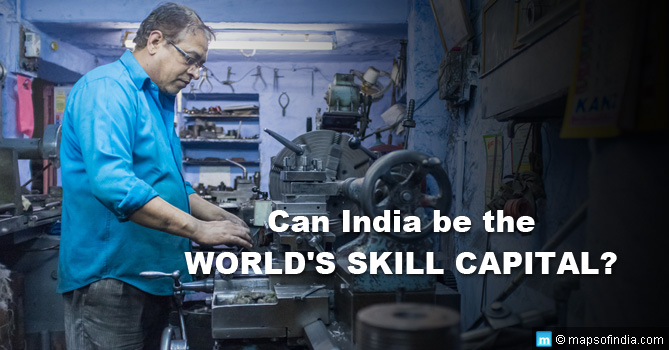Can India be the World’s Skill Capital?
Last month, in September 2016, the Union Minister of State for Skill Development and Entrepreneurship, Mr. Rajiv Pratap Rudy revealed the NDA government’s vision for skills development in the country. India will soon be the skill capital of the world, he said. The minister was speaking in a session focused on Leadership Orientation at the CII-Suresh Neotia Centre of Excellence for Leadership symposium called “Preparing for Tomorrow through Entrepreneurship and Skill Development”. While the vision to build India into a skills hub, the dream to create a manufacturing and services destination is a beautiful one, it is also a highly ambitious and challenging endeavour.
A Floundering Dream
With a population of 1.32 billion, India is one of the most populous countries of the world. According to news reports, in just another decade, about 70 percent of the nation’s population is likely to be in the working age group. With such a huge working population, employment generation and poverty alleviation will naturally feature high on the government’s agenda. Universal education is still a concern we are grappling with. We also need to consider that over 5 million children drop out of our education system each year. And even if we make education available to great numbers, employability of the youth is one major issue that needs to be addressed. Only about 5 percent of the entire workforce available in the country may be considered to have had access to formal skills training of any sort. The dream of transforming India into the world’s favorite destination seems to be faltering when faced with the high proportion of trained workforce available in other countries. Studies suggest that about 68 percent of the workforce in the UK is trained, in Germany this figure is about 75 percent, and 52 percent in the USA. Coming back to Asia, 80 percent of the Japanese workforce is highly trained and skilled while this is as high as 96 percent in South Korea
A Look at the Numbers
In June this year, the government of India made sweeping changes to the FDI (foreign direct investment) policy of the country. Such radical liberalisation means that a number of important sectors including civil aviation, defence, pharmaceuticals, and single brand retail are now open to 100 percent foreign ownership. For the first time since 2002, India has featured among the top 10 FDI attracting nations of the world. Does our skills development programme support our ambitions? According to recent estimates about 104 million young men and women in the country are likely to require skills training in the next 6 years. In the same timeframe, some 298 million people (part of the current workforce) will also be up for retraining or to update their skillsets with newer learning. It is high time India takes skills development seriously since this is set to be the foundation of the nation’s economic development.
Pradhan Mantri Kaushal Vikas Yojana (PMKVY)
The NDA government has indeed rightly identified the need for training and skills development in the country. The launch of the PMKVY in July 2015, under the aegis of National Skill Development Corporation, was in the first step in this direction. The scheme was launched on 15 July 2015, a day designated National Skills Day to highlight the importance of the PMKVY. The initial target of the scheme is to train some 2.4 million youth from the lower income strata of Indian society. The outlay planned for the PMKVY is about INR 1500 crore. The government has partnered with numerous training facilities across the country to set up about 2300 training centres imparting various skill based training. Training, examination, and certification are one side of the programme and encouraging entrepreneurial ambitions is another. The PMKVY ultimately intends to fit India with the skill requirements that are being looked for by investors.
Roping in the Private Sector
The mammoth task of skills development in India and transformation of the nation into the skills capital of the world is not something that can be achieved by the government alone. No matter how large the budgetary allocation, unless the government takes steps to join hands with the private sector, neither is the programme sustainable, nor will it result in enhanced employment opportunities for the youth. A number of such joint cooperative training programmes with private companies have shown immense success. Bosch, the German engineering and electronics manufacturer, for example has been one of the best collaborators when it comes to skills training of Indian youth from their centres in Bengaluru.
Skills Development and Social Empowerment
The challenge of employability of youth is one that the government is attempting to address by imparting skill based training and by various other skill development programs. This may also be the key to uplifting hundreds of thousands of families from below poverty line. Given its immense importance in nation building and economic restructuring of the country, it is important that the government start looking at expanding the scope and focus on PMKVY. Linking up the Skills India program with central and state government recruitment mechanisms is also important.
Dreaming an ambitious dream is easy. It is quite certain that we are all rooting for a glorious India to ride the developmental wave and transform itself into the go-to destination when it comes to manufacturing and services. But realistically speaking, there is a huge gap we need to bridge before we come close to realizing this ambition. Empowering the youth and setting up a self-reliant generation must essentially start with equipping the youth with skills that will allow them to work and develop themselves in the years to come.
Read More:
USTAD – Skills Upgradation and Training Initiative for Craftsmen
Schemes Launched by Modi Government
‘Stand up India’ Scheme by PM Modi : Highlights, Objectives, Benefits, Process
PM’s Employment Generation Programme (PMEGP) : Details, Benefits, Objective, Eligibilit
Gram Uday Se Bharat Uday Abhiyan
Setu Bharatam Project
Pradhan Mantri Ujjwala Yojana
Atal Pension Yojana
MUDRA Bank Yojana
Sukanya Samriddhi Account
Pradhan Mantri Jeevan Jyoti Bima Yojana (PMJJBY)
Pradhan Mantri Suraksha Bima Yojana (PMSBY)
Pradhan Mantri Kaushal Vikas Yojana
Pradhan Mantri Krishi Sinchai Yojana
Pradhan Mantri Awas Yojana (PMAY)
One Rank One Pension Scheme
Seventh Pay Commission
Garib Kalyan Yojana
All Information about Digital India Programme
DigiLocker
eBasta – Features and Benefit for students
Atal Mission for Rejuvenation and Urban Transformation
Mahatma Gandhi National Rural Employment Guarantee Act (MGNREGA)
Beti Bachao Beti Padhao Scheme
Pahal Scheme
Jan Dhan Yojana
Skill India Programme
Swachh Bharat Abhiyan: Making India Clean & More
Pradhan Mantri Fasal Bima Yojana (PMFBY)





